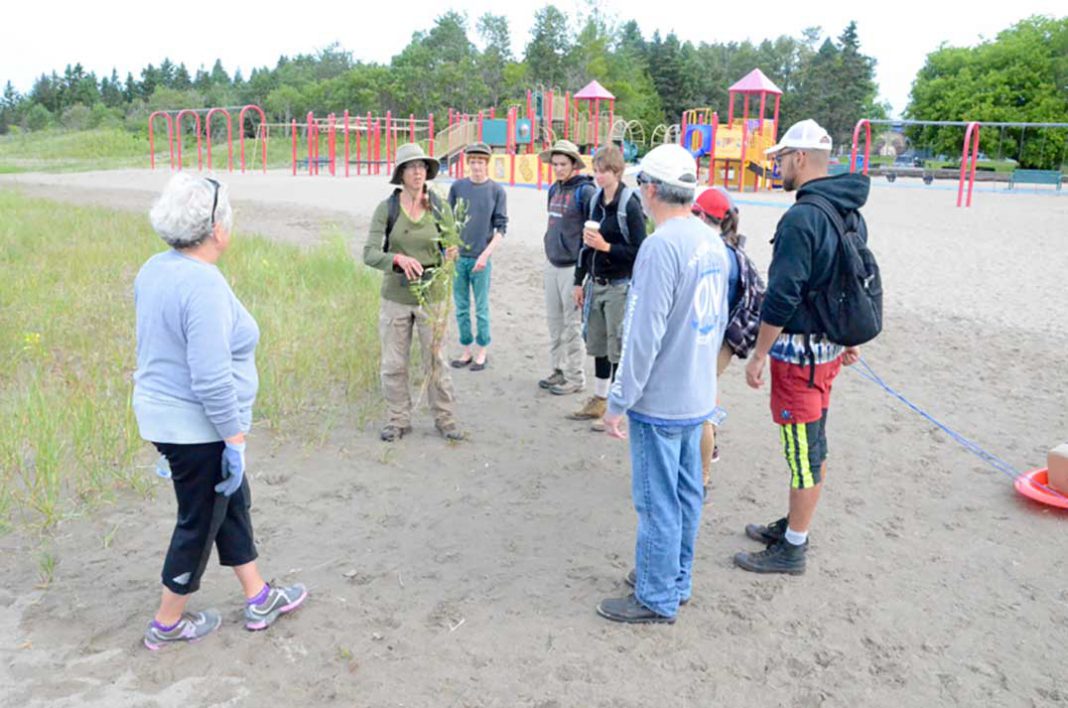PROVIDENCE BAY—Threatening clouds overhead did nothing to deter a group of volunteers who were intent on removing invasive species from the sands and dunes of the Providence Bay beach.
This year’s efforts follow on a major cleanup effort that took place last year and the results from last year’s outing were clearly evident on the beach this year. “What a difference,” said Manitoulin biologist Judith Jones as she took a moment out from overseeing the volunteers’ efforts.
Although the work was taking place a little earlier this year than last, so the plants were somewhat smaller than they would be later in the summer, it was clear there were far fewer plants cluttering up the beach than was the case last year.
“We have to be really careful to only remove those plants that don’t belong here,” cautioned Ms. Jones. “I know that some people would like us to be taking away everything, but we are not allowed to do that.” Actually, removing all of the vegetation would be very counterproductive, even if it was allowed, as the natural grasses that inhabit the beach area help to stabilize the sands and the dunes where people want them to be.
Photographs from decades past, as well as council reports from back in the day, make it clear that errant sand blowing through the streets was a significant challenge. By concentrating on only the invasive species, i.e. those plants like sweet clover that do not belong on the beach, the ecology of the beach will return to something much more natural and sustainable in the future.
As the volunteers began their work, threats turned to reality and a torrential downpour inundated the beach area, soaking those on the beach and sending a young family who had been fishing running for shelter.
“I am so proud of everybody who came out,” said Ms. Jones. “Nobody took off, they all stuck around and kept working through it all.”
Volunteers hauled a large blue tarp across the beach on which the volunteers piled their harvested plant matter so as not to allow any errant seeds to spread. Paper bags were also on hand as receptacles.
Further down the beach a distinct lack of vegetation spoke volumes to the effectiveness of the municipalities’ efforts to combat invasive phragmites that have been bedeviling the beach in recent years as well. The municipality applied for a permit to conduct the phragmites control work last year.
“It has really been a success story,” said Central Manitoulin Economic Development Officer Nancy Kinoshameg. “We are looking at doing some work in that vein in my own community (Wiikwemkoong) in the near future as well.”
Hitting stands of invasive species impacting Island waterways and beaches as early as possible, before they are firmly established, helps play a huge role in keeping the spread and congestion under control.
“It really shows that this isn’t a hopeless fight,” said Ms. Kinoshameg. “If you get on it early, you can make a real difference.”
As to the work on Providence Bay beach the old adage that “many hands makes light work” was demonstrated as the volunteers swept across the landscape, quickly putting paid to stands of unwelcome greenery infesting the dunes.
“If we can make these kind of events a yearly thing, we can really help to keep our waters clear and our waterfronts accessible,” noted Ms. Jones. “It can be done.”



